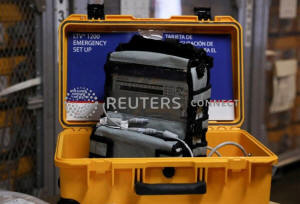One ventilator, two patients: New York hospitals shift to crisis mode
 Send a link to a friend
Send a link to a friend
 [March 27, 2020]
By Jonathan Allen and Nick Brown [March 27, 2020]
By Jonathan Allen and Nick Brown
NEW YORK (Reuters) - At least one New York
hospital has begun putting two patients on a single ventilator machine,
an experimental crisis-mode protocol some doctors worry is too risky but
others deemed necessary as the coronavirus outbreak strains medical
resources.
The coronavirus causes a respiratory illness called COVID-19 that in
severe cases can ravage the lungs. It has killed at least 281 people
over a few weeks in New York City, which is struggling with one of the
largest caseloads in the world at nearly 22,000 confirmed cases.
A tool of last resort that involves threading a tube down a patient's
windpipe, a mechanical ventilator can sustain a person who can no longer
breathe unaided. The city only has a few thousand and is trying to find
tens of thousands more.
Dr. Craig Smith, surgeon-in-chief at New York-Presbyterian/Columbia
University Medical Center in Manhattan, wrote in a newsletter to staff
that anesthesiology and intensive care teams had worked "day and night"
to get the split-ventilation experiment going.

By Wednesday, he wrote, there were "two patients being carefully managed
on one ventilator."
New York Governor Andrew Cuomo, who says his staff is struggling to find
enough machines on the market, has touted the adaptation as a potential
life-saver. "It's not ideal," he told reporters, "but we believe it's
workable."
The U.S. Food & Drug Administration, which regulates medical device
manufacturers, gave emergency authorization on Tuesday allowing
ventilators to be modified using a splitter tube to serve multiple
COVID-19 patients, though manufacturers still must share safety
information with regulators.
Some medical associations oppose the unproven method.
On Thursday, the Society of Critical Care Medicine, the American
Association for Respiratory Care and four other practitioner groups
issued a joint statement saying the practice "should not be attempted
because it cannot be done safely with current equipment."
[to top of second column]
|

A ventilator is seen at the New York City Emergency Management
Warehouse, where 400 ventilators arrived and before being shipped
out for distribution, due to concerns over the rapid spread of
coronavirus disease (COVID-19) in the Brooklyn borough of New York
City, U.S., March 24, 2020. REUTERS/Caitlin Ochs/File Photo

It is difficult enough to fine-tune a ventilator to keep alive even
one patient with acute respiratory distress syndrome (ARDS), the
statement said; sharing it across multiple patients would worsen
outcomes for all. They proposed doctors instead choose the one
patient per ventilator deemed most likely to survive.
At Columbia, Smith noted that they could not split a ventilator
across just any two COVID-19 patients, but were only pairing
patients with sufficiently similar respiratory needs.
Across Manhattan, Mount Sinai Hospital told staff in an email that
officials were "working to figure out" whether they could split
ventilators. The hospital has ordered the necessary adapters, a
nurse there said in an interview on condition of anonymity because
she was not authorized to speak to reporters.
Experts at Columbia pointed to a 2006 study where researchers, using
lung simulators, concluded that a single ventilator could sustain
four adults in an emergency scenario.
One author of that study, Dr. Greg Neyman, cautioned against the
application in COVID-19 cases in part because the lungs themselves
are infected. If one patient's lungs were deteriorating faster, he
said, it could cause imbalances in the closed system. One patient
could starve for oxygen while the other patient's lungs would get
increased pressure.

"Unless they were very very closely monitored, such a set up may end
up doing more harm than good," Neyman wrote in an email to Reuters.
(Reporting by Jonathan Allen and Nick Brown; Editing by David
Gregorio)
[© 2020 Thomson Reuters. All rights
reserved.] Copyright 2020 Reuters. All rights reserved. This material may not be published,
broadcast, rewritten or redistributed.
Thompson Reuters is solely responsible for this content. |